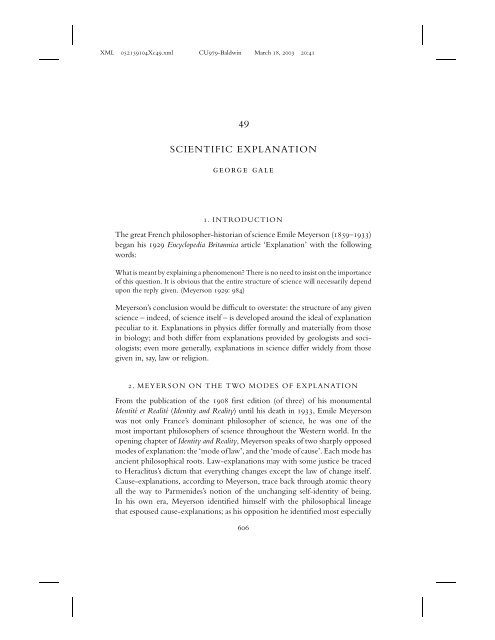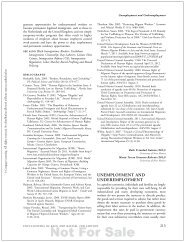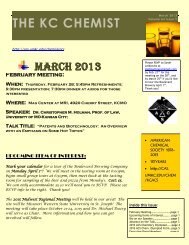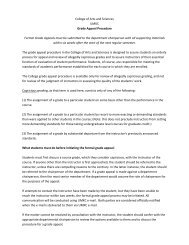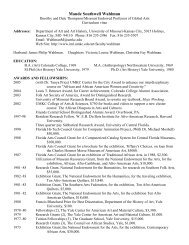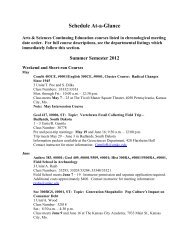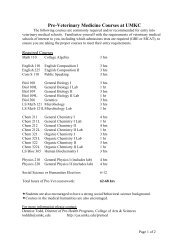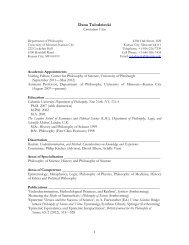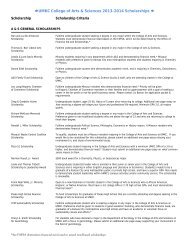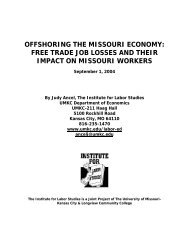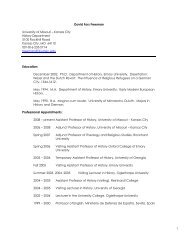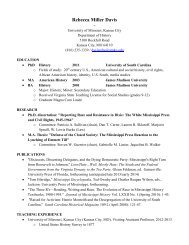SCIENTIFIC EXPLANATION george gale
SCIENTIFIC EXPLANATION george gale
SCIENTIFIC EXPLANATION george gale
You also want an ePaper? Increase the reach of your titles
YUMPU automatically turns print PDFs into web optimized ePapers that Google loves.
XML 052159104Xc49.xml CU979-Baldwin March 18, 2003 20:41<br />
49<br />
<strong>SCIENTIFIC</strong> <strong>EXPLANATION</strong><br />
<strong>george</strong> <strong>gale</strong><br />
1. INTRODUCTION<br />
The great French philosopher-historian of science Emile Meyerson (1859–1933)<br />
began his 1929 Encyclopedia Britannica article ‘Explanation’ with the following<br />
words:<br />
What is meant by explaining a phenomenon? There is no need to insist on the importance<br />
of this question. It is obvious that the entire structure of science will necessarily depend<br />
upon the reply given. (Meyerson 1929: 984)<br />
Meyerson’s conclusion would be difficult to overstate: the structure of any given<br />
science – indeed, of science itself – is developed around the ideal of explanation<br />
peculiar to it. Explanations in physics differ formally and materially from those<br />
in biology; and both differ from explanations provided by geologists and sociologists;<br />
even more generally, explanations in science differ widely from those<br />
given in, say, law or religion.<br />
2. MEYERSON ON THE TWO MODES OF <strong>EXPLANATION</strong><br />
From the publication of the 1908 first edition (of three) of his monumental<br />
Identité et Realité (Identity and Reality) until his death in 1933, Emile Meyerson<br />
was not only France’s dominant philosopher of science, he was one of the<br />
most important philosophers of science throughout the Western world. In the<br />
opening chapter of Identity and Reality, Meyerson speaks of two sharply opposed<br />
modes of explanation: the ‘mode of law’, and the ‘mode of cause’. Each mode has<br />
ancient philosophical roots. Law-explanations may with some justice be traced<br />
to Heraclitus’s dictum that everything changes except the law of change itself.<br />
Cause-explanations, according to Meyerson, trace back through atomic theory<br />
all the way to Parmenides’s notion of the unchanging self-identity of being.<br />
In his own era, Meyerson identified himself with the philosophical lineage<br />
that espoused cause-explanations; as his opposition he identified most especially<br />
606
XML 052159104Xc49.xml CU979-Baldwin March 18, 2003 20:41<br />
Scientific explanation 607<br />
Comte, Mach, and their followers in positivism, among whom he numbered<br />
his contemporary Pierre Duhem and the members of the Vienna Circle.<br />
To speak very roughly, the two forms of explanation may be characterised<br />
as follows. Law-explanations show that phenomena are related in dependable<br />
patterns. Meyerson quotes Berkeley’s view as paradigmatic:<br />
For the laws of nature being once ascertained, it remains for the philosopher to show<br />
that each thing necessarily follows in conformity with these laws; that is, that every<br />
phenomenon necessarily results from these principles. (Berkeley 1901: §37)<br />
Taine puts it even more simply: ‘A stone tends to fall because all objects tend<br />
to fall’ (Taine 1897: 403–4). An adequate law-explanation, then, is produced<br />
by showing that some target phenomenon is a consequence of an accepted<br />
rule, or, best, of a well-established law of nature. For the most part, French<br />
philosophers of our period – with the exception of Duhem and also Poincaré –<br />
were not legalistes (supporters of law-explanations). It was among the Anglo-<br />
Saxons, including Russell, Bridgeman, Carnap, and others of the Vienna Circle,<br />
that the law-explanation was brought to its highest perfection, as we will see<br />
below.<br />
Meyerson links modern cause-explanation to Leibniz’s principle of sufficient<br />
reason, most especially its dynamical statement that ‘the whole effect can reproduce<br />
the entire cause or its like’ (Leibniz 1860: 439). Underlying this, Meyerson<br />
notes, ‘we see that the principle of Leibniz comes back to the well-known formula<br />
of the scholastics, causa aequat effectum’ (Meyerson 1908 [1930]: 29). Thus,<br />
‘the principle of causality is none other than the principle of identity applied to<br />
the existence of objects in time’ (Meyerson 1908 [1930]: 43). Although murky as<br />
here stated, when cashed out in practice the principle is clear enough: ‘according<br />
to the causal principle’, in an adequate explanation ‘the original properties plus<br />
the change of conditions must equal the transformed properties.’ (Meyerson<br />
1908 [1930]: 41). In other words, an adequate cause-explanation necessarily entrains<br />
an object or objects, and describes how these objects preserve relevant<br />
aspects of their identity throughout the change. Prototypical examples of this<br />
type of explanation would include chemical equations which exhibit the conservation<br />
of mass and energy at the level of the atom, ion, or molecule. Since<br />
Meyerson was a trained chemist, his choice of prototype is not in the least odd.<br />
Underlying Meyerson’s distinction between the two forms of explanation<br />
is his analysis of the goals of science. Science, he says, has two separate and<br />
distinct goals. The first is a utilitarian one, namely, science serves to make our<br />
lives easier, or better, or, in some cases, possible at all. This it does through<br />
prediction: ‘foresight is indispensable for action’ and ‘action for any organism<br />
of the animal kingdom is an absolute necessity’ (Meyerson 1962: 22). Thus,
XML 052159104Xc49.xml CU979-Baldwin March 18, 2003 20:41<br />
608 George Gale<br />
the dog, when pursuing the rabbit, is able to foresee – to predict – the path of<br />
his quarry. Humanity’s science, according to proponents of law-explanation, is<br />
nothing less than an exquisite means to satisfy this necessity. Meyerson quotes<br />
Poincaré with satisfaction: ‘“Science” as H. Poincaré has so well said, “isarule<br />
of action which succeeds”’ (Meyerson 1908 [1930]: 20; Poincaré 1902a: 265).<br />
Proponents of law-explanation justify their choice by arguing that science’s goal<br />
is prediction alone.<br />
On the other hand, underlying cause-explanation is the deeply human need<br />
to understand: Meyerson again cites Poincaré, who ‘says: “In my view knowledge<br />
is the end, and action is the means [and] Aristotle had already said: ‘All<br />
men by nature are actuated by the desire for knowledge’.”’ (Meyerson 1908<br />
[1930]: 42; Poincaré 1902a: 266). Referring again to Leibniz’s version of the<br />
principle of cause-explanation, Meyerson remarks: ‘wherever we establish it,<br />
the phenomenon becomes rational, adequate to our reason: we understand it<br />
and we can explain it. This thirst for knowledge, for understanding, is felt by<br />
each one of us’ (Meyerson 1908 [1930]: 42).<br />
Scientific reasoning, indeed, scientific rationality, is not in principle different<br />
from ordinary, common sense, human reasoning and rationality. In ordinary<br />
reasoning, a phenomenon is made understandable, ‘rational’, when it has been<br />
linked to an object, its properties, and its behaviour. Science, according to<br />
Meyerson, is nothing more than the extension of ‘common sense’ into new<br />
domains: in this role, science creates, invents, discovers new sorts of objects<br />
which can act as the causes of phenomena which are beyond ordinary experience.<br />
Thus, the ordinary concept of ‘boiling’ and an object’s ‘boiling point’ is<br />
linked to the disappearance of a spot of a new substance, gasoline (Meyerson<br />
1908 [1930]: 45).<br />
3. OTHER EPISTEMOLOGISTES<br />
Léon Brunschvicg (1869–1944) was not a philosopher of science in the same<br />
measure as Meyerson: although Brunschvicg based his thought in the history of<br />
science (as well as in the history of Western philosophy), his focus upon science<br />
was as means, and not as end. Brunschvicg’s goal was to understand how reason<br />
contributed to human experience, and, in so doing, became ever more conscious<br />
of itself over time. Since, like Meyerson, Brunschvicg believed that the history<br />
of science captured some of the finest examples of the powers and behaviours of<br />
human reason at work, analysis of the history of science would serve his goal of<br />
understanding reason and its works. Brunschvicg, again like Meyerson, believed<br />
that the mind itself made a significant contribution to the world as it was finally<br />
known: ‘Positive science goes from the mind to matter, and not from matter
XML 052159104Xc49.xml CU979-Baldwin March 18, 2003 20:41<br />
Scientific explanation 609<br />
to the mind’ (Brunschvicg 1931: 144). Yet, his idealism was not unalloyed; in<br />
the end knowledge was a product both of the mind and of matter, working<br />
together, in an essentially dialectical interaction. Most importantly, Brunschvicg<br />
viewed science as a dynamic process, an open-ended creative action, that not<br />
only exhibited the speculative freedom of the mind, but also assured humanity’s<br />
practical liberty.<br />
Brunschvicg’s ideas about scientific theorising and explanation were less dramatic.<br />
A hypothesis or explanation was true just in case it was intelligible. Over<br />
time, the dialectic between scientific reasoning and matter ‘gives to thought<br />
an increasing approximation to reality’ (Brunschvicg 1905: 12). It is evident<br />
that both the spirit of Brunschvicg’s thought, as well as some of its particular<br />
doctrines, were influential during the period between the wars. After all,<br />
he occupied the chair of general philosophy at the Sorbonne for thirty years:<br />
1909–39. One philosopher of science who came especially under his influence<br />
was Gaston Bachelard.<br />
Bachelard (1884–1962) was a late bloomer: he started his work life as a postman;<br />
later, in 1913, he got a teaching certificate and taught secondary-school<br />
science for fourteen years. Then, in 1927, he got his doctorate and in 1930<br />
became professor of philosophy in Dijon. His experiences as a science teacher<br />
directly affected his philosophy of science. At the time when he was teaching,<br />
the ministry of education kept extremely tight reins on what would be taught in<br />
science, and how. In particular, the strictures forced an ontology-free positivism:<br />
‘One was directed not to speak the word “atom”. One always thought about<br />
it; but one could never speak about it. Some authors . . . gave a short history<br />
of atomist doctrines, but always after a totally positivist exposition’ (Bachelard<br />
1933: 93). As far as Bachelard was concerned, this was all wrong: ‘In actual fact,<br />
as Meyerson has proved, science usually postulates a reality’ (Bachelard 1969: 13;<br />
Jones 1991: 24). But, except for the usual focus upon the knower, and agreement<br />
about foundations in history of science, this was one of the few points where<br />
Bachelard’s philosophy agreed with that of his older colleague, Meyerson.<br />
From Brunschvicg, Bachelard got the idea of the open-endedness of the task<br />
of scientific reasoning. He communicates this notion in a particularly evocative<br />
way: ‘The scientist leaves his laboratory in the evening with a program of work<br />
in mind, and he ends the working day with this expression of faith, which is<br />
daily repeated: “Tomorrow, I shall know”’ (Bachelard 1973: 177; Jones 1991:<br />
59). Bachelard’s doctoral thesis was entitled Essai sur la connaissance approchée<br />
(Essay on the Approach on Knowledge) (1969); this connotes (at least in French) the<br />
notion of knowledge as approximate, ‘being approached only as a limit’, perhaps<br />
even, ‘under construction’. Again, the root of the idea is found in Brunschvicg:<br />
knowledge is a product, a synthesis produced by the mutual interaction between
XML 052159104Xc49.xml CU979-Baldwin March 18, 2003 20:41<br />
610 George Gale<br />
the mind and the world. Although Bachelard himself does not use the term<br />
‘dialectic’ to refer to this interaction, Brunschvicg would not have so hesitated;<br />
neither should we: knowledge is produced by two compelling, albeit contradictory,<br />
impulses: ‘rationalism’ and ‘realism’. In practice, these two metaphysics<br />
play out simply enough: ‘if scientific activity is experimental, then reasoning will<br />
be necessary; if it is rational, then experiment will be necessary’ (Bachelard 1973: 7;<br />
Jones 1991: 48). Obviously, what is involved here is mutual interaction between<br />
mind and matter in producing knowledge. But mutuality is not equality: in<br />
the end, at least in post-Einsteinian science, it is the rationality of mathematics<br />
which will prove most significant over against the matter of experimental<br />
reality:<br />
Mathematical realism, in some shape, form, or function, will sooner or later come along<br />
and give body to thought, making it psychologically permanent, ...revealing, here as<br />
everywhere else, the dualism of the subjective and the objective. (Bachelard 1973: 8;<br />
Jones 1991: 49; author’s italics)<br />
This remark shows two important ways in which Bachelard differs from<br />
Meyerson. In the first place, Bachelard believed that Einstein’s relativity theory<br />
represented so great a divergence from earlier theories – mostly because it raised<br />
to an unprecedented level the ontological creative power of mathematicisation –<br />
that it required a ‘break’ (= rupture) in philosophy of science, a rupture of the<br />
classical from the modern. Meyerson argued, in opposition, that relativity theory<br />
in fact represented the triumph of classical mechanics. The two thinkers<br />
fought it out in book-length form: Meyerson’s La Déduction relativiste 1925 versus<br />
Bachelard’s La Valeur inductive de la relativité (1929). The opposition between<br />
Meyerson’s ‘deduction’ and Bachelard’s ‘induction’ in their respective book-titles<br />
is especially salient: after Einstein, Bachelard believed, all attempts to use deductive<br />
logic in scientific explanations are fruitless. Meyerson believed precisely the<br />
opposite.<br />
The second issue dividing the two men follows directly on the first. According<br />
to Meyerson, scientific reasoning – most particularly, scientific explanation –<br />
is not different in kind from reasoning in ordinary common affairs. Reason’s<br />
activities were then, are now, and will always be the same. Bachelard denied this<br />
flat out. Because post-relativity scientific thinking mathematicises the world in<br />
an entirely new way, the world as newly mathematicised reaches back into the<br />
thinking apparatus and re-shapes it; thus the new explanatory achievements<br />
produce a psychologically ‘permanent’ change, an epistemological rupture in<br />
the manner of thinking itself (Bachelard 1973: 59). It follows from this that<br />
scientific thinking in general, and scientific explaining in particular, is different<br />
from what it once was; most especially, it is and can no longer be, deductive.
XML 052159104Xc49.xml CU979-Baldwin March 18, 2003 20:41<br />
Scientific explanation 611<br />
It is obvious from even this short discussion that these French thinkers have<br />
had enormous influence throughout the twentieth century. Meyerson’s historical<br />
approach, plus his conclusion that scientific theories and explanations necessarily<br />
include ontologies, were taken up intact by Kuhn, as he himself admitted.<br />
Brunschvicg and Bachelard adopted historical approaches as well, and added<br />
to Meyerson’s thinker-centred idealism the notion of the open-ended ‘project’<br />
of constructing scientific knowledge. This latter view is now, sixty years later,<br />
one of the major themes in end-of-the-century science studies. Clearly, the<br />
French causalistes held significance far beyond their own times. But France did<br />
not hold a monoply on cause-explanation proponents.<br />
4. NORMAN CAMPBELL<br />
Norman Campbell (1880–1949) was an English physicist who, after reflecting<br />
deeply upon his practice, developed and propounded an influential philosophy of<br />
science. Like Meyerson, he believed that explanation in science was contiguous<br />
with explanation in ordinary life; moreover, again similarly to Meyerson, he<br />
held that explanations necessarily entrained causes: objects, their properties,<br />
and interactions. Finally, writing of the positivists, and most certainly Mach in<br />
particular, he wrote: ‘I cannot understand how anybody can find any interest<br />
in science, who thinks that its task is completed with the discovery of laws’<br />
(Campbell 1921: 89).<br />
Laws, of course, are part of a scientific theory. But, thought Campbell, they<br />
are not the important part; indeed, almost invariably, discoverers of laws ‘have<br />
no claim to rank among the geniuses of science’ (Campbell 1921: 92). On the<br />
other hand, every important explanatory theory ‘is associated with some man<br />
whose scientific work was notable apart from that theory’ either because of<br />
other important discoveries or because of their ‘greatly above average work’<br />
(Campbell 1921: 92). Explanations do their work by reducing the unfamiliar to<br />
the ‘familiar’ (Campbell 1921: 77). The reduction takes place when the objects,<br />
properties, or interactions in the unfamiliar system are placed in analogy with<br />
objects, properties, or interactions in a familiar system:<br />
The explanation offered by a theory . . . is always based on an analogy and the system<br />
with which an analogy is traced is always one of which the laws are known. (Campbell<br />
1921: 96)<br />
Moreover, the familiar system ‘is always one of those systems which form part<br />
of that external world’ which science studies (Campbell 1921: 96). Analogies,<br />
therefore, inevitably make claims about what exists in the external world.
XML 052159104Xc49.xml CU979-Baldwin March 18, 2003 20:41<br />
612 George Gale<br />
Campbell’s prototypical case involves gases. The laws of the behaviour of<br />
gases – Boyle’s Law and Gay-Lussac’s Law are his examples – are well known.<br />
But what makes these laws intelligible, what provides an explanation, is the<br />
Dynamical Theory of Gases: ‘a gas consists of an immense number of very<br />
small particles, called molecules, flying about in all directions, colliding with<br />
each other and with the wall of the containing vessel ...etc.’ (Campbell 1921:<br />
81). The phenomena described by the two laws – pressure, for example – are<br />
explained by the movements and interactions of the molecules. But the reason<br />
this explanation succeeds is simply the fact that the movements of the molecules<br />
are analogous to motions in the ordinary world:<br />
the behaviour of moving solid bodies is familiar to every one; every one knows roughly<br />
what will happen when such bodies collide with each other or with a solid wall ...Movement<br />
is just the most familiar thing in the world...Andsobytracing a relation between<br />
the unfamiliar changes which gases undergo when their temperature or volume is altered,<br />
and the extremely familiar changes which accompany the motions and mutual reactions<br />
of solid bodies, we are rendering the former more intelligible; we are explaining them.<br />
(Campbell 1921: 84)<br />
With Campbell we reach the last cause-explanation advocate of the period from<br />
1915 to 1945. We now turn to an examination of the other side of the controversy<br />
and examine the views of those who argued that scientific explanations are<br />
provided by applications of laws, those philosophers called positivists.<br />
5. POSITIVISM<br />
positivism began as a reform movement, an attempt to bring philosophical salvation<br />
to wayward science (Gale 1984: 491). Two names are especially associated<br />
with the origins of positivism, those of the French mathematician and social<br />
scientist Auguste Comte (1798–1857), and the German physicist Ernst Mach<br />
(1838–1916). As all reform movements must, positivism contained both an attack<br />
upon a perceived evil, and a manifesto proclaiming the correct way forward. The<br />
attack focused upon the metaphysical proclivities of then-contemporary science.<br />
Explanatory hypotheses such as atomic theory and, for Mach especially, energy,<br />
and absolute space and time, were taken to be speculative excesses, unverifiable<br />
postulates about forever-hidden structures of Reality. The problem with<br />
causal explanations, according to positivism, is that they tend to be wrong, and,<br />
once new theories are proposed, old hypotheses must be discarded along with<br />
the commitments of the scientists who believe them. A major case in point<br />
was Lavoisier’s revolution in chemistry, during which the substance ‘phlogiston’
XML 052159104Xc49.xml CU979-Baldwin March 18, 2003 20:41<br />
Scientific explanation 613<br />
went out of existence, only to be replaced by the substance ‘oxygen’. Science,<br />
according to the positivists, simply had no need to become involved with such<br />
illusory entities.<br />
What behoved science was to stick to its ‘positive’ (hence the name) contributions:<br />
the well-verified laws which tended to remain constant even through<br />
a drastic revolution, such as Lavoisier’s. Moreover, according to the positivists,<br />
laws satisfied the most important goal of science, its utilitarian promise to provide<br />
prevision, prediction, of the future course of events. Although elimination<br />
of cause-explanation would leave unattained humankind’s desire for intellectual<br />
satisfaction – the goal of science according to Meyerson, Bachelard, et al. –<br />
law-explanation and its attendant prediction was a safe and eminently satisfiable<br />
goal.<br />
Underlying the safety of law-explanation and prediction was a thoroughgoing<br />
empiricism, a commitment to exclude from science all notions, concepts, and<br />
words which could not, one way or another, be tied to entities apparent to<br />
the senses. Thus, following Hume, in order for a term to have any meaning at<br />
all, it must be tied to some observable entity. For example, ‘pressure of a gas’<br />
could be tied to the felt elasticity of a balloon, or, perhaps, the visible reading<br />
of a manometer. But since ‘an atom’ provided no such empirically observable<br />
concomitant, the term had no meaning at all; hence the concept, and its verbal<br />
expression, must be discarded from science. The ultimate sought-for goal was the<br />
reformulation of all scientific theories in meaningful terms, terms with direct ties<br />
to empirical observation. This would be accompanied by the elimination of all<br />
meaningless terms, that is, all those terms such as ‘atom’, ‘energy’, and ‘absolute<br />
space and time’, which referred to entities hidden or otherwise unavailable to<br />
empirical observation.<br />
Two French thinkers added significant elements to the positivist tradition.<br />
These are the physicists Henri Poincaré(1854–1912) and Pierre Duhem (1861–<br />
1916). For both men the only acceptable theory is one which is strictly mathematical;<br />
this because, as Poincare notes, the sole end of theory ‘is to co-ordinate<br />
the physical laws which experience makes known to us, but which, without<br />
the help of mathematics, we could not even state’ (Poincaré 1889: 1). Duhem,<br />
Meyerson remarks, ‘affirms in the same way that the mathematical theory is<br />
not an explanation, but a system of mathematical propositions; it classifies laws’<br />
(Meyerson 1962: 52). Duhem was a genuinely talented historian of physics; he<br />
knew full well that ‘several of the geniuses to whom we owe modern physics<br />
have constructed their theories in the hope of giving an explanation of natural<br />
phenomena’ (Duhem 1906: 46). Yet, as Meyerson remarks, Duhem’s ‘own ideas<br />
are diametrically opposed to this manner of thinking’ (Meyerson 1908 [1930]:
XML 052159104Xc49.xml CU979-Baldwin March 18, 2003 20:41<br />
614 George Gale<br />
53). Duhem’s heroically steadfast rejection of metaphysics, directly in the face of<br />
his own thorough grounding in the history of his subject, served as an inspiration<br />
to later positivists.<br />
Poincaré’s contribution was more direct. Although both he and Duhem were<br />
strictly committed to mathematicised theories in physics, just as Mach before<br />
them, this commitment, when carefully examined, represented a sharp<br />
challenge to their equally strict empiricist beliefs. Although ‘pressure of a gas’<br />
and ‘volume of a gas’ are concepts which can be cashed in via empirical observations,<br />
what can be made of the mathematical operations contained in, say,<br />
Boyle’s law that the pressure multiplied by the volume of a given container of<br />
gas has a constant product throughout changes in either? That is, what is one to<br />
make of the ‘×’ and the ‘=’ in the law p1 × v1 = p2 × v2? At least prima facie,<br />
multiplication signs and equal signs do not signify anything genuinely empirical.<br />
Poincaré made a very sensible response to this difficulty. He proposed that<br />
mathematical operations referred to the behaviour of physicists; that is, through<br />
convention, physicists had come to agree to use multiplication and equality<br />
as procedures during instances of Boyle’s Law applications. Thus, if one were<br />
to observe a physicist doing a Boyle’s Law application, one would observe the<br />
physicist measuring the pressure of the gas, then measuring the volume of the gas<br />
and then multiplying the measurements. The physicists’ ‘multiplying the measurements’<br />
is just as empirically observable as their ‘measuring the volume’.<br />
This conventionalist analysis extended to all mathematical operations; indeed,<br />
as we shall see, it applied to all formal manipulations, including those of formal<br />
logic.<br />
Poincaré’s solution became a permanent part of the positivist view. At about<br />
the same time, however, a development of equal significance to the development<br />
of positivism was taking place in England. I refer, of course, to Russell and<br />
Whitehead’s development of symbolic logic (Whitehead and Russell 1910–13).<br />
6. ADDING LOGIC TO POSITIVISM<br />
Philosophical concern to impose logical methods on scientific thinking is an<br />
ancient and honorable endeavour. It was Aristotle himself who laid it down<br />
that deductive logical structure is a necessary condition for any discipline to call<br />
itself ‘scientific’. Descartes and Leibniz reaffirmed this demand during the early<br />
stages of modern science. But none of these projects fully succeeded. What was<br />
missing was a sufficiently rich, powerful, and precise logical apparatus. Deductive<br />
syllogisms produced from the syntax and semantics of everyday speech just<br />
could not do the job capturing the richness of scientific language. Whitehead<br />
and Russell’s axiomatic system for symbolic logic, the logic of quantifiers and
XML 052159104Xc49.xml CU979-Baldwin March 18, 2003 20:41<br />
Scientific explanation 615<br />
predicates with identity, made available for the first time a language which<br />
seemed to offer the potential to allow the empiricist re-formulation so desired<br />
by the positivists. Thus did the positivists become the ‘logical’ positivists (or, in<br />
some camps, and for obvious reasons, the ‘logical’ empiricists).<br />
Rudolf Carnap (1891–1970) presented the first mature interpretation of logical<br />
positivism in his 1928 Der logische Aufbau der Welt. Carnap, true to Mach’s<br />
empiricism, employs as his central concept Zurückführbarkeit, or‘reducibility’, a<br />
process through which one concept is reformulated in terms of other(s). A concept<br />
x is said to be reducible to a set of concepts Y if every sentence concerning<br />
x can be reformulated in sentences concerning concepts belonging to Y, with<br />
no loss of truth. The reformulation is carried out according to a ‘constitutional<br />
definition’, one side of which is ultimately – perhaps through more reformulations<br />
– linked to a ‘basis’, a set of basic objects. For Carnap, at this stage of<br />
development staying close and true to Mach’s sensationalism, the basic objects<br />
were mental objects: a certain kind of experience. During the reformulation<br />
process, the number of, and number of kinds of, concepts was sizeably reduced,<br />
with the result that the final product, the concepts of the basis, would be both<br />
simplest and minimum in number.<br />
Carnap’s basic concepts got their meaning by being cashed into statements<br />
about mental experiences. Although this procedure certainly satisfies most<br />
empiricist criteria of meaning (including the very one Carnap used, which<br />
he called ‘Wittgenstein’s principle of verifiability’), it did not satisfy Carnap’s<br />
Vienna Circle colleagues, in particular, Otto Neurath, who was a thoroughgoing<br />
physicalist. After some argument, Neurath convinced Carnap that basic concepts<br />
should be defined in physicalist terms, that is, by reference to quantitative descriptions<br />
of events occurring at definite spatio-temporal locations. Neurath preferred<br />
this physicalist language because it allowed for agreement among observers<br />
about the occurrence or non-occurrence of the event referred to (Neurath<br />
1932). Moreover, since the language symbolised the events of physics, it would<br />
serve to capture all other sciences which, presumably, would be reducible to<br />
physics. Thus, for example, theories in chemistry or biology would be formulatable<br />
in terms of the physicalist basis concepts.When fully implemented, the<br />
physicalist basis would accomplish once and for all that long-sought Holy Grail of<br />
all empiricist proponents of law-explanation, the elimination from science of the<br />
metaphysical excesses hypothesised by the cause-explainers. This achievement<br />
was duly announced by Carnap in his article ‘Überwindung der Metaphysik<br />
durch logische Analyse der Sprache’ (‘The Elimination of Metaphysics through<br />
the Logical Analysis of Language’) (Carnap 1932).<br />
A final fillip was added to physicalist empiricism by the Nobel-prize-winning<br />
American physicist: W. Bridgman (1882–1961). Bridgman held that Einstein’s
XML 052159104Xc49.xml CU979-Baldwin March 18, 2003 20:41<br />
616 George Gale<br />
brilliant achievement in discovering relativity theory did not come through a<br />
disclosure of facts or by showing something new about nature. Rather, Einstein’s<br />
discovery dramatically highlighted the value of sound conceptual analysis: after<br />
an analysis of then-current notions of time, and the operations used in measuring<br />
it, Einstein, according to Bridgman, saw that the concept of time, as generally<br />
understood, was severely flawed (Bridgman 1936).<br />
For example, Einstein saw that there was no possible way to measure whether<br />
two spatially separated events were simultaneous or not. Hence ‘simultaneity<br />
of occurrence’ was a temporal concept that could not be given a meaning in<br />
terms of a measuring operation. But since this very concept was fundamental in<br />
Newtonian theory, Einstein’s analysis suggested that Newtonian theory was fundamentally<br />
flawed, and needed to be replaced. Based upon this case, Bridgman<br />
argued forcefully for elimination from physics of all concepts which could not<br />
be defined in terms of operations, actual measurements, carried out by actual<br />
physicists.<br />
The empiricist bent of this, not to mention its positivist reformational spirit,<br />
will not go unnoticed. Although not all logical positivists adopted Bridgman’s<br />
emendation, many did. Moreover, scientists in psychology (e.g., Skinner) and<br />
linguistics (e.g., Bloomfield) called for operationalist reform. With Bridgman’s<br />
contribution, logical positivism was finally in a position to provide a canonical<br />
formulation of its view on scientific theories. This is what it looked like:<br />
A theory is an axiomatised deductive system formulated in a symbolic language<br />
having the following elements:<br />
1. The theory is formulated in a first-order mathematical logic with equality, L<br />
2. The nonlogical terms or constants of L are divided into three disjoint classes called<br />
vocabularies:<br />
a. The logical vocabulary consisting of logical and mathematical constants.<br />
b. The observation vocabulary, V0 containing observation terms.<br />
c. The theoretical vocabulary, VT containing theoretical terms.<br />
3. The terms in V0 are interpreted as referring to directly observable physical objects or<br />
directly observable attributes of physical objects.<br />
4. There is a set of theoretical postulates T whose only nonlogical terms are from VT.<br />
5. The terms in VT are given an explicit definition in terms of V0 by correspondence rules<br />
C – that is, for every term ‘F’ in VT, there must be a definition for it of the form<br />
‘(∀x)(Fx ≡ Ox)’ where ‘Ox’ is an expression of L containing symbols only from V0<br />
and possibly the logical vocabulary.<br />
(But it must be kept in mind that various aspects of the positivist view on theories<br />
were in nearly constant change from the first moment of their publication<br />
in 1928; most of the changes concerned clauses 2 and 5, particularly where their<br />
content involved the logic of the conditional.)
XML 052159104Xc49.xml CU979-Baldwin March 18, 2003 20:41<br />
Scientific explanation 617<br />
An example of this approach applied to the theory of metals might look<br />
something like this:<br />
Observation vocabulary, Vo:<br />
conducts electricity, is ductile, expands, is heated<br />
Theoretical vocabulary, VT:<br />
is a metal<br />
In accordance with clause 5, the predicate ‘is a metal’ would thus be introduced<br />
by a correspondence rule, in this case:<br />
(∀x)[x is a metal ≡ (x is ductile &xconducts electricity)]<br />
that is, metals are things which are ductile and conduct electricity. Laws of<br />
Nature presumably would be postulates (or, in some cases, axioms or theorems)<br />
of the theory. The following might be taken to be a plausible example of a Law<br />
of Nature:<br />
(∀x)[(x is a metal &xisheated) → x expands]<br />
i.e. metals expand when heated.<br />
7. PREDICTION, <strong>EXPLANATION</strong> AND<br />
THE COVERING-LAW MODEL<br />
As noted earlier, law-explainers typically take prediction to be science’s goal.<br />
For the most part, the logical positivists agree with this position, but with a<br />
very interesting twist. The logical positivist account of explanation is embedded<br />
in the view of theories and laws given just now, and one of its features is the<br />
symmetry of explanation and prediction. According to this view, an explanation<br />
and a prediction have exactly the same logical form, but with reversed timesignatures.<br />
Thus, an explanation is a ‘prediction’ of the past (sometimes called a<br />
‘retrodiction’), and a prediction is an ‘explanation’ of the future! What lies at the<br />
center of the doctrine is the single logical form which serves both explanations<br />
and predictions; let us therefore examine the logical form of explanations.<br />
In this account, L stands for a suitable Law; and C stands for an initial (factual)<br />
condition. The form of an explanation is:<br />
L1,...,Ln, C1,...,Cn (Explanans)<br />
E (Explanandum)<br />
Thus the Law(s) in conjunction with the initial conditions – the ‘explanans’ –<br />
are sufficient to imply logically the explanandum, that is, the phenomenon<br />
needing to be explained. The name ‘covering law model’ of explanation comes
XML 052159104Xc49.xml CU979-Baldwin March 18, 2003 20:41<br />
618 George Gale<br />
from the fact that laws are used to ‘cover’ all the cases needing explanation. Here<br />
is a simple example:<br />
Phenomenon / Query: ‘Why did the copper penny (p) expand when heated?’<br />
Explanans:<br />
Law: (∀x) [(x is a metal & x is heated) → x expands]<br />
Conditions: p is a metal & p was heated<br />
Explanandum:<br />
p expands<br />
It is clear that such explanations function as deductive arguments. In justifying<br />
a prediction exactly the same form would obtain, but the initial query and the<br />
verb tense would be different:<br />
Query: What would happen if I heated this copper penny?<br />
Prediction: Given that this copper penny is metal, if it were heated it would<br />
expand.<br />
It should be noted that the account presented here was never given as such<br />
by any particular logical positivist thinker, especially as regards its rendering in<br />
logical symbols. However, given what many of these thinkers stated, remarked,<br />
and argued at various time during the 25-year history of this model, they would<br />
be hard put to provide an account materially different from that presented here.<br />
8. CONCLUSION<br />
After a brief hiatus during the Second World War, philosophers of science resumed<br />
work on the problems of scientific explanation. For the most part, the<br />
Anglophone community counted itself among the legalistes, more particularly,<br />
especially in America, as logico-empirico-positivists. Yet opposition from the<br />
causalistes never entirely disappeared. By the 1960s, the legalist model of explanation<br />
was under serious attack, from both within and without. Harré and Hesse,<br />
for example, continued the Meyersonian-Campbellian tradition of emphasis<br />
upon the role of analogies and models, with their attendant causal ontologies.<br />
Indeed, Hesse’s (1966) dialogue featured a legalist called ‘The Duhemist’ pitted<br />
against a causalist called, naturally enough, ‘The Campbellian’. Kuhn, with explicit<br />
reference to Meyerson, opposed an historical methodology to the logical<br />
perspective of the positivists, with devastating results.<br />
In the end, what is perhaps surprising is that the entire century’s agenda<br />
for philosophical controversy about scientific explanation was effectively set, in<br />
France, by the argument in 1908 between Poincaré and Duhem – the legalists –<br />
and Meyerson – the causalist. In a very real sense, much of the following ninetytwo<br />
years of philosophical controversy are footnotes to that argument.


